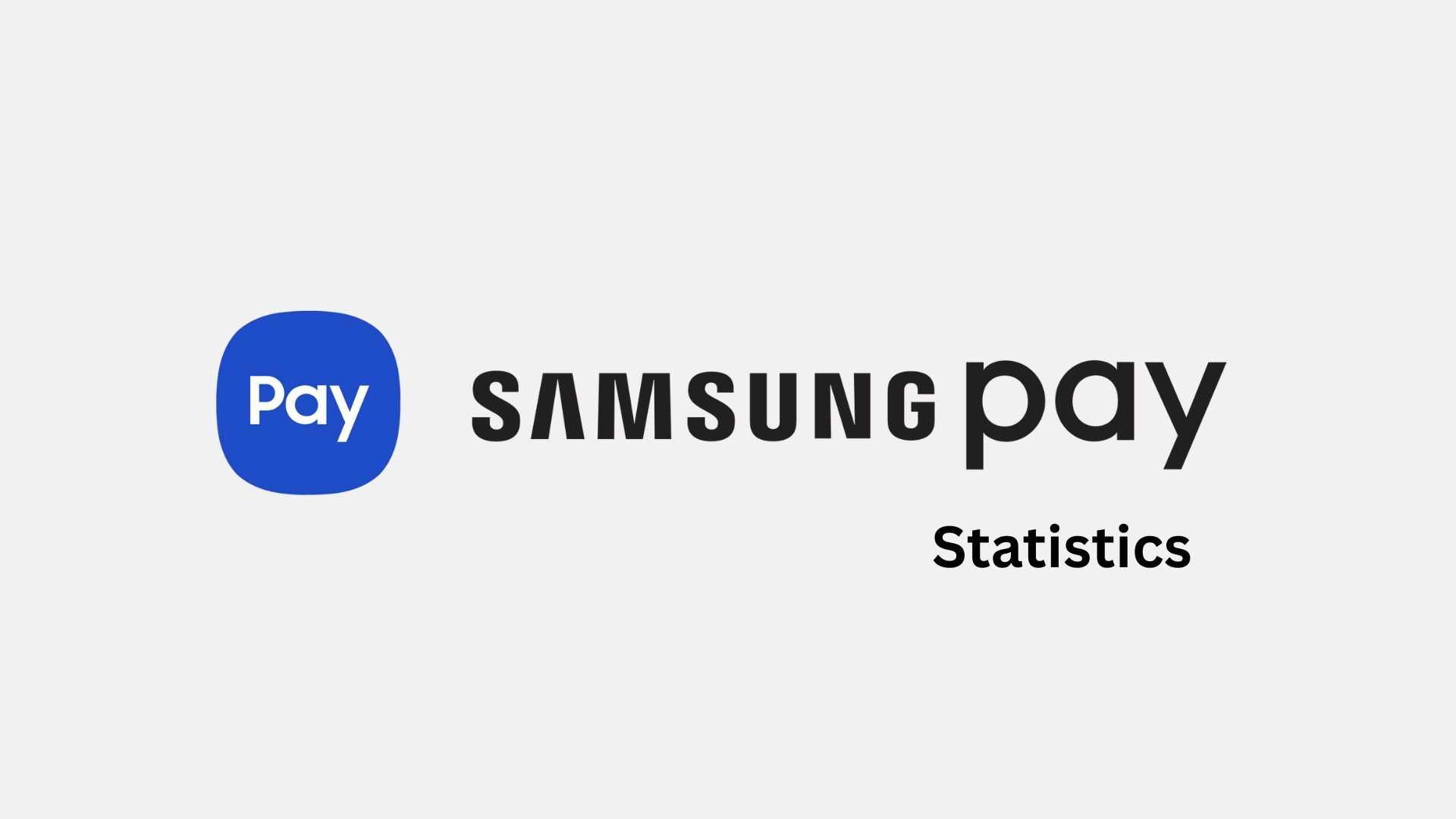Samsung Pay Statistics, Facts By Adoption Rates, Market Share, Demographics, Users, Growth And Security (2025)
Updated · Oct 09, 2025

Table of Contents
Introduction
Samsung Pay Statistics: Imagine the ease of buying a cup of morning coffee with a quick tap of one’s phone. Thus, fast, safe, and deservedly normal. Samsung Pay (now largely integrated into Samsung Wallet) has been one of the big players in making this possible.
In 2025, while the world of mobile wallets expands at an incredibly fast rate, Samsung Wallet is growing alongside it. Below will be some clear, numbered facts and percentages relating to Samsung Pay Statistics in 2025.
Editor’s Choice
- Samsung Pay operates in 29 countries and is expected to add 5 more by the year 2025, with the Asia-Pacific region already comprising 40% of its user base.
- In South Korea, eight out of 10 smartphone owners use Samsung Pay on a day-to-day basis, implying a deep fold in daily life.
- Samsung Pay accounts for 14% of the global mobile payment market, making it the third-largest mobile wallet in the world, with 25% market share in the Asia-Pacific.
- Having dual compatibility for both NFC and MST, Samsung Pay channels about 20% of global NFC payments while leading 35% of Android wallet transactions.
- Payment of retail accounts for 75% of Samsung Pay transactions, surpassing all competitors.
- The average transaction size of Samsung Pay is US$42.50, which is higher than Apple Pay’s US$35 and Google Pay’s US$30.
- Samsung Pay caters to U.S. users between 18 and 34, with a slight male skew of 55.9%.
- In the UK, 62.1% of users fall in the age group of 25 to 34 years; the majority of them are male, accounting for 75.8%.
- Samsung Pay India maintains a user base of 2.5 million and has invested ₹4,915 crore at Noida for capacity expansion.
- Numbering US$4.7 trillion in 2025, the global mobile payment market together accounts for Samsung Pay transactions of US$342 billion.
- The total transaction volume increased 17.9% year-over-year, outpacing the industry’s growth of 13%.
- Speaker: These 85% of users employ NFC regularly. P2P transactions have increased by 28% to US$67 billion.
- Loyalty program integration has resulted in a 25% retention increase, while retail partnerships have pushed online transactions by 34%.
Global Adoption Rates
- Samsung Pay is one of the few mobile payment systems with a rapid growth rate and user loyalty around the world.
- It is currently in 29 countries and is to be expanded to five other regions by 2025.
- Adoption is highest in the Asia-Pacific region, consisting of about 40% of users, with North America trailing behind with about 25%.
- As its stronghold, it has absorbed around 80% of mobile payment users in South Korea, suggesting a very deep integration of Samsung Pay into daily life there.
- Usage has been emerging rapidly in Europe, with a 15% year-on-year growth, currently being driven by adoption in Germany, the United Kingdom, and France.
- Growing very fast, India and Brazil mark a rise of about 25% in the active user base of Samsung Pay, which is further powered by the mass adoption of Samsung phones.
- Now, over 70% of merchants accept Samsung Pay in the United States, owing to the compatibility it offers with both NFC (Near Field Communication) and MST (Magnetic Secure Transmission) technologies, which together allow it to function at old payment terminals.
- There is much heat for user retention as well. In regions where Samsung Pay is integrated into a public transportation system, such as Singapore and Australia, retention went up by 12%.
- This is an indicator that convenience factors, like tapping one’s phone to pay for a train or bus trip, keep users returning to Samsung Pay with regular use.

(Source: coinlaw.io)
- As per Coin Law, Samsung Pay statistics show that Samsung Pay is still pushing hard in the digital payment space, maintaining a solid position among its major counterparts such as Apple Pay and Google Pay.
- The service holds a fair chunk of 14% of the global mobile payment market, which explanation for it ranking third among the global mobile wallets.
- Its performance within the Asia-Pacific region is actually more impressive, holding the top anchor with a 25% market share.
- This can be almost attributed to massive patronage in South Korea and a few countries in Southeast Asia, where Samsung smartphones enjoy great popularity.
- One major factor in favouring Samsung Pay is its dual compatibility with NFC (Near Field Communication) and MST (Magnetic Secure Transmission).
- This means that the wallet would be accepted by a larger number of payment terminals, which contributes to about 20% of global NFC payments.
- Samsung Pay enjoys even greater prominence within the Android ecosystem, which it commands with approximately 35% market share of all Android-based mobile wallet transactions, thus overtaking Google Pay in this segment.
- Roughly 75% of Samsung Pay’s transactions are retail transactions.
- This is slightly greater than Google Pay, wherein retail payments make up 65% of the total, and Apple Pay makes up 58%.
- In the United States, however, the numbers are still favourable for Samsung Pay. It is growing steadily, the penetration rate hitting 10%, even when competition is fierce.
- From a spending perspective, Samsung Pay users tend to make larger purchases on average.
- The average transaction on the platform is about US$42.50, which is higher than US$35 for Apple Pay and US$30 for Google Pay.
- This implies that Samsung Pay users are very active but also tend to use the service for medium- or high-value transactions.
Samsung Pay US Users By Demographics

(Source: start.io)
- The data illustrates the greatest popularity for Samsung Pay among young adults, with nearly half of the user base, or 48.4%, being aged between 18 and 24 years.
- The second biggest age group (33.1%) is 25-34 years of age, which visibly means the service is favoured by tech-savvy millennials and Gen Z consumers.
- Usage stutteringly climbs down as the older groups come in: only 8.1% are 35-44, 3.3% are 45-54, and 7.1% are 55-plus.
- Men dominate the gender-wise distribution of the Samsung Pay users at 55.9%, with women occupying 44.1% of the total, which marks a moderate but noticeable male skew in the user demographics.
User Insights – United Kingdom

(Source: coinlaw.io)
- In the UK, Samsung Pay is most favoured by young adults, with its users comprising 62.1% of the 25-to-34 age group. 18.7% are of 18–24 age, and 8.5% are of 35–44 age.
- A steep fall in usage occurs as we go higher in age groups, with just 1% of users in the 45–54 age group and 9.8% above 55.
- The user base is overwhelmingly male, constituting 75.8% of total users, while 24.2% are female.
- Regarding devices, Samsung Galaxy S9 leads as the most used for Samsung Pay, followed by the Galaxy S8, S10, S9+, and S10+, in that order.
Users of Samsung Pay In India
- Samsung has grown drastically in its digital payments ecosystem; it boasts an over 2.5 million user base of Samsung Pay across India.
- The service, launched in early 2017, is now turning quite fast, with customers embracing cashless transactions with greater inclination.
- Aditya Babbar, General Manager at Samsung India, said that the company is further strengthening its operations by investing ₹4,915 crore in its Noida facility to double production capacity to meet increased demand.
- The data of GfK, a research agency, states that as of September, Samsung had an impressive 47% of the total market share in the Indian smartphone segment, cementing its leadership position.
- Tamil Nadu remains among the core five markets of Samsung, where one-third of the phones are sold from the popular Samsung “J series.”
- Equally essential for the company is a vast retail network comprising 1.5 lakh outlets across India, including 1,900 company-owned stores.
- The strong distribution aligns with the success of both marketing for its smartphones and its digital payments.
Growth of Samsung Pay Mobile Payment
- Mobile payment today is on a rapid expansion, and Samsung Pay sits amongst the key entities driving this movement.
- The worldwide mobile payment market is forecasted to touch US$4.7 trillion in 2025, with Samsung Pay accounting for US$342 billion in transaction value.
- Transaction volume saw a 17.9% growth YoY, bettering the general industry growth at 13%.
- User engagement is all-time high, with about 85% of Samsung Pay users utilising NFC for contactless payment with online shopping: a favourable sign that users have greater confidence in tap-to-pay technology.
- Meanwhile, peer-to-peer transaction volume also saw a 28% surge and stood at US$67 billion globally in 2025.
- The platform experienced a 12% increase in user base; the growth can be attributed to robust adoption across Asia-Pacific, Europe, and Latin America.
- User retention increased by 25% as loyalty and rewards programs were integrated, which was another success story for Samsung Pay, while retail partnerships increased online transactions by 34%.
- Besides, Samsung Pay widened its footprint by launching in six new countries in 2025, further cementing its position and demonstrating its capability to adapt to regional digital payment ecosystems.
Mobile Payment Security Statistics
- Security is a defining advantage for Samsung Pay that lends it user trust and industry leadership.
- In 2025, 98% of Samsung Pay users showed strong confidence in using it, attributing security to patches like tokenization and biometrics.
- The frequency of fraudulent transactions is 25% down, with the platform detecting and blocking threats in real time. 85% of payment users cited features like their fingerprint or iris scan as the reason for choosing Samsung Pay.
- Since launch, the payment service has never suffered a single major security breach, cementing its reputation for reliability and protection.
- In regions such as the United States and Europe, enhanced encryption and data privacy lead 60% of users to favour Samsung Pay over conventional payment methods.
- Also, with the integration of Samsung Knox, Samsung’s enterprise security platform, device-level protection has since been increased by 30%, thereby decreasing exposure to cyber threats and malware attacks.
Technological Advances
- Samsung Pay further solidifies its stature as a leading digital payment scheme through the application of advanced technologies and user-centric innovations.
- One of the most crucial developments is AI-based fraud detection systems that analyse and monitor transaction patterns in real time, consequently resulting in a 40% reduction in fraud attempts and enhancing the security of the platform.
- Voice-activated payment has also recently been introduced in selective markets, which allow users to transact without using their hands, further enriching convenience and accessibility.
- One more giant step has been cryptopayments via Samsung Pay in the early-adopting regions, enabling transactions with 10 of the top cryptocurrencies.
- The transactions are 30% faster with 5G technology integration now for a smoother and quicker payment experience.
- The other interesting feature is smart budgeting tools, wherein users can set spending limits and get real-time alerts, leading to 20% more user engagement.
- The platform has also increased its presence in wearables, with almost 15% of all transactions happening via Samsung smartwatch now.
- Improved QR code payment facilities allow merchants in remote/demanding environments to easily accept payments without the need for NFC-enabled terminals.
Conclusion
Samsung Pay Statistics: Samsung Pay is the foremost global mobile payment platform that interconnects convenience, security, and technological innovation. With operations in 29 countries, with plans to extend even further, it continues to draw the tech-savvy, particularly those in Asia-Pacific, the United States, and Europe. Deployment in retail and integration with loyalty programmes combine to provide a strong draw to users.
Samsung Pay’s advanced security features, AI-powered fraud detection, cryptocurrency support, 5G-based transactions, and integration with wearable devices stand tall in Samsung Pay’s pursuit of safety and innovation. With the growing trend of mobile payments, Samsung Pay continues to be considered a dependable and user-driven mobile-payment platform.
Sources
FAQ.
Currently, Samsung Pay provides services in 29 countries, with 40% of its users being from the Asia-Pacific region. South Korea leads the adoption rate, with eight in 10 smartphone owners using it on a routine basis.
By 2025, 98% of users strongly agreed with the statement that Samsung Pay was secure. Tokenization, biometric authentication, and Samsung Knox integration aid in limiting fraud, resulting in a 25% decrease in attempts of fraudulent transactions since then. There have not been any significant security breaches reported since the inception of the platform.
Samsung Pay holds 14% of the mobile payment market in the world and 25% in the Asia-Pacific. The amount of transactions surged by 17.9% from last year, 4.9% higher than the estimated global average of 13%, with a predicted total of US$342 billion from transactions in 2025.
Samsung Pay is the most popular with young adults. Almost 48% of people within the age group of 18-24 are active users, with the 25-34 age group following at 33% in the U.S. 48% of Samsung Pay providers aged 25-34 in the U.K. are mostly males; 75.8% are men.
Samsung Pay integrates artificial intelligence-driven fraud detection, voice payments, cryptocurrency support, 5G-powered transaction speeds, smart budgeting, wearable integration, and enhanced QR code functionality—making transactions faster and more convenient and secure.

I hold an MBA in Finance and Marketing, bringing a unique blend of business acumen and creative communication skills. With experience as a content in crafting statistical and research-backed content across multiple domains, including education, technology, product reviews, and company website analytics, I specialize in producing engaging, informative, and SEO-optimized content tailored to diverse audiences. My work bridges technical accuracy with compelling storytelling, helping brands educate, inform, and connect with their target markets.










